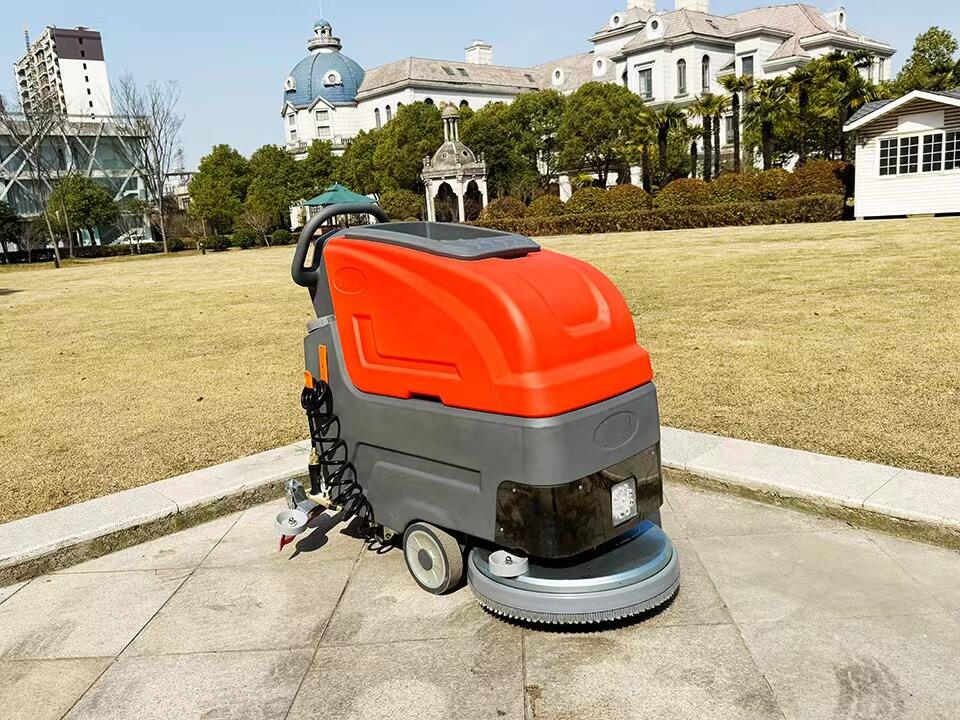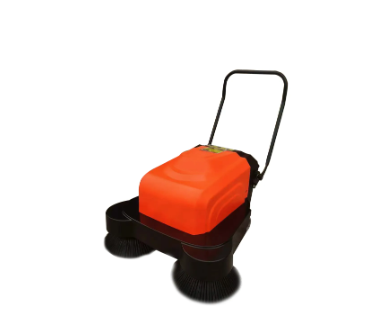การทำความเข้าใจประเภทต่าง ๆ ของเครื่องกวาดถนนเพื่อเพิ่มประสิทธิภาพโครงการ
เครื่องกวาดแบบใช้มือ vs. เครื่องยนต์: การเลือกกำลังให้เหมาะสมกับขนาดพื้นที่
การทำความเข้าใจความแตกต่างระหว่างเครื่องกวาดแบบใช้มือและแบบเครื่องยนต์มีความสำคัญอย่างมากต่อประสิทธิภาพของโครงการ เครื่องกวาดแบบใช้มือ เครื่องถมถนน ทำงานโดยไม่มีมอเตอร์ โดยอาศัยแรงผลักจากผู้ใช้งานเพื่อเคลื่อนที่แปรงหมุน ทำให้เหมาะสำหรับพื้นที่ขนาดเล็ก เนื่องจากมีราคาถูกและใช้งานง่าย ในทางกลับกัน เครื่องดูดฝุ่นถนนแบบมีมอเตอร์จะช่วยเพิ่มประสิทธิภาพ ความรวดเร็ว และลดต้นทุนแรงงาน ซึ่งสามารถเพิ่มประสิทธิภาพในการทำความสะอาดได้อย่างมาก อีกรายงานในอุตสาหกรรมระบุว่า เครื่องดูดฝุ่นแบบมีมอเตอร์สามารถเพิ่มประสิทธิภาพการสะอาดได้มากถึง 70% เมื่อเทียบกับวิธีการแบบแมนนวล นอกจากนี้ แม้ว่าเครื่องดูดฝุ่นแบบแมนนวลอาจมีราคาถูกกว่าในระยะแรก แต่ค่าใช้จ่ายในระยะยาวเกี่ยวกับแรงงานและเวลา อาจทำให้เครื่องดูดฝุ่นแบบมีมอเตอร์เป็นตัวเลือกที่ประหยัดกว่าสำหรับโครงการขนาดใหญ่
Walk-Behind vs. Ride-On: การเลือกความคล่องตัวและการครอบคลุมพื้นที่
การเลือกระหว่างรถกวาดถนนแบบเดินตามและแบบนั่งขับจำเป็นต้องพิจารณาความคล่องตัวและการครอบคลุมพื้นที่ให้เหมาะสม รถกวาดแบบเดินตามเหมาะสำหรับพื้นที่ขนาดกลาง เสนอแรงขับเคลื่อนแบบมอเตอร์และใช้งานง่าย ซึ่งช่วยลดความเมื่อยล้าของผู้ปฏิบัติงานและเพิ่มประสิทธิภาพการทำงาน ในทางกลับกัน รถกวาดแบบนั่งขับเหมาะกับพื้นที่ขนาดใหญ่กว่า สามารถใช้งานได้ถึง 8,000 ตารางเมตร เนื่องจากให้ความสะดวกสบายแก่ผู้ปฏิบัติงานและเพิ่มผลผลิตได้มากกว่า ต้นทุนในการดำเนินงานและเวลาที่ประหยัดมีความแตกต่างกันอย่างมากระหว่างสองประเภทนี้ โดยทั่วไปแล้วรถกวาดแบบนั่งขับจะถูกแนะนำสำหรับโครงการทางเทศบาลที่กว้างขวาง เนื่องจากพื้นที่การกวาดที่กว้างกว่าและลดความจำเป็นในการใช้แรงงานคน
เครื่องกวาดถนนติดตั้งบนรถบรรทุกสำหรับใช้งานในเทศบาลขนาดใหญ่
รถติดตั้งเครื่องดูดถนนมีความจำเป็นอย่างยิ่งสำหรับงานทำความสะอาดระดับเทศบาลขนาดใหญ่ เครื่องดูดเหล่านี้รวมเอาความแข็งแรงทนทานของระบบกลไกเข้ากับความสามารถในการทำความสะอาดพื้นที่เมืองกว้างขวาง โดยใช้คุณสมบัติต่างๆ เช่น ถังเก็บน้ำขนาดใหญ่ และความสามารถในการรับมือกับเศษขยะจำนวนมาก เพื่อเพิ่มประสิทธิภาพการใช้งาน การเคลื่อนย้ายที่คล่องตัวช่วยให้สามารถปฏิบัติงานในเครือข่ายถนนได้อย่างมีประสิทธิภาพ เมืองที่นำโซลูชันแบบติดตั้งบนรถบรรทุกมาใช้ มีรายงานว่าสามารถลดเวลาได้อย่างมาก ซึ่งแสดงให้เห็นถึงประสิทธิภาพของอุปกรณ์ชนิดนี้ ความสำเร็จของเทศบาลเมืองต่างๆ ในการใช้รถดูดถนนเหล่านี้ แสดงให้เห็นถึงบทบาทสำคัญของพวกเขาในการรักษาความสะอาดและความมีประสิทธิภาพในการดำเนินงานของเมืองในระดับใหญ่โต
ระบบดูด vs. ระบบแปรงกลไก
เมื่อพูดถึงการเก็บกวาดเศษวัสดุ ระบบดูดฝุ่นและระบบแปรงกลไกมีข้อได้เปรียบในการปฏิบัติงานที่แตกต่างกัน ระบบดูดฝุ่นมีความโดดเด่นในพื้นที่เขตเมืองหรือพื้นที่ที่มีการจราจรหนาแน่น เนื่องจากสามารถควบคุมฝุ่นละอองได้ถึง 90% ซึ่งมีความสำคัญอย่างมากต่อการรักษาคุณภาพอากาศในท้องถิ่น ระบบนี้ใช้หลักการดูดเพื่อเก็บรวบรวมเศษวัสดุ ซึ่งมีประสิทธิภาพสูงโดยเฉพาะกับอนุภาคขนาดเล็ก ในทางกลับกัน ระบบแปรงกลไกจะอาศัยแปรงที่หมุนเพื่อเก็บขยะ ซึ่งเหมาะกับพื้นที่ที่มีเศษวัสดุขนาดใหญ่มากกว่า เมื่อเปรียบเทียบด้านค่าบำรุงรักษาและการดำเนินงาน ระบบดูดฝุ่นอาจมีค่าใช้จ่ายเริ่มต้นที่สูงกว่า แต่ประสิทธิภาพในการควบคุมฝุ่นละอองของระบบนี้คุ้มค่ากับการลงทุน โดยเฉพาะในสภาพแวดล้อมที่มีข้อกำหนดด้านคุณภาพอากาศที่เข้มงวด

ประเมินปริมาณเศษวัสดุและประเภทพื้นผิวสำหรับโครงการของคุณ
คำนวณปริมาณเศษวัสดุ: ฝุ่นบางเบา ปะทะ ขยะก่อสร้างหนัก
การกำหนดปริมาณเศษวัสดุเป็นสิ่งสำคัญต่อการเลือกเครื่องกวาดถนนที่เหมาะสม เนื่องจากประสิทธิภาพในการทำความสะอาดขึ้นอยู่กับความเข้าใจที่ชัดเจนเกี่ยวกับประเภทของเศษวัสดุ ในการคำนวณประเภทของเศษวัสดุให้มีประสิทธิภาพ ผู้ใช้งานจำเป็นต้องประเมินขอบเขตโครงการและปัจจัยแวดล้อม เครื่องกวาดถนนที่ออกแบบมาโดยเฉพาะสำหรับฝุ่นบางเบาหรือเศษซากจากการก่อสร้างหนักๆ มีความสามารถที่แตกต่างกัน เครื่องกวาดเศษวัสดุเบาเหมาะสำหรับพื้นที่ที่มีสิ่งกีดขวางน้อย ในขณะที่เครื่องกวาดเศษวัสดุหนักสามารถจัดการเศษซากขนาดใหญ่ เช่น คอนกรีตและโลหะได้ ปริมาณเศษวัสดุส่งผลโดยตรงต่อต้นทุนและประสิทธิภาพในการดำเนินงาน ข้อมูลจากการสำรวจล่าสุดแสดงให้เห็นว่า การเลือกเครื่องกวาดให้สอดคล้องกับปริมาณเศษวัสดุสามารถเพิ่มประสิทธิภาพการกวาดได้มากถึง 40% ทำให้การประเมินที่ถูกต้องเป็นขั้นตอนสำคัญในทุกโครงการ
ถนนลาดยางเทียบกับพื้นที่ขรุขระ: การตรวจสอบความเข้ากันได้ของพื้นผิว
การเลือกเครื่องจักรกวาดถนนที่เหมาะสมกับประเภทพื้นผิวต่างๆ มีความสำคัญอย่างยิ่งในการหลีกเลี่ยงความไม่มีประสิทธิภาพและปัญหาความเสียหายที่อาจเกิดขึ้น โดยทั่วไป ถนนที่ปูแล้วสามารถใช้เครื่องกวาดถนนมาตรฐานส่วนใหญ่ได้ ซึ่งช่วยให้การทำงานราบรื่นและมีประสิทธิภาพสูงสุด อย่างไรก็ตาม พื้นที่ที่มีลักษณะขรุขระจำเป็นต้องใช้เครื่องจักรที่ทนทานมากกว่า ออกแบบมาเพื่อรองรับสภาพแวดล้อมที่ท้าทาย มีกรณีศึกษาหลายตัวอย่างที่แสดงให้เห็นว่า การใช้อุปกรณ์ที่ไม่เหมาะสมบนพื้นผิวที่ไม่เรียบ นำไปสู่ความเสียหายและประสิทธิภาพการปฏิบัติงานที่ลดลง เพื่อลดปัญหาเหล่านี้ ผู้ผลิตได้มีการกำหนดแนวทางโดยละเอียดสำหรับการเลือกเครื่องกวาดที่เหมาะสมกับแต่ละประเภทของภูมิประเทศโดยเฉพาะ จากผลการวิจัยพบว่า หากเลือกใช้อุปกรณ์ที่ไม่เข้ากันกับพื้นผิว จะทำให้ต้นทุนในการดำเนินงานเพิ่มขึ้นได้สูงถึง 30% ซึ่งเน้นย้ำถึงความสำคัญของการตัดสินใจอย่างรอบคอบเมื่อประเมินประเภทของพื้นผิว
การเปรียบเทียบระหว่างการกวาดแบบเปียกกับแบบแห้งสำหรับการควบคุมฝุ่น
เทคนิคการกวาดแบบเปียกและแบบแห้งมีข้อดีต่างกันขึ้นอยู่กับสภาพแวดล้อม การกวาดแบบเปียกมีประสิทธิภาพสูงโดยเฉพาะในการควบคุมฝุ่นละอองในอากาศ โดยเฉพาะในพื้นที่เขตเมืองที่ให้ความสำคัญกับการลดฝุ่น ในทางตรงกันข้าม การกวาดแบบแห้งจะถูกนำมาใช้ในสภาพที่มีข้อจำกัดในการใช้น้ำ หรือเมื่อมีฝุ่นน้อย สถิติแสดงให้เห็นว่าในพื้นที่เขตเมือง การกวาดแบบเปียกสามารถควบคุมฝุ่นได้มีประสิทธิภาพมากกว่าวิธีแบบแห้ง ผู้เชี่ยวชาญแนะนำให้คำนึงถึงปัจจัยด้านสิ่งแวดล้อม เช่น สภาพอากาศ ในการตัดสินใจเลือกวิธีการกวาดที่เหมาะสม การเลือกใช้เทคนิคการกวาดให้สอดคล้องกับความต้องการของสภาพแวดล้อม จะช่วยให้โครงการต่าง ๆ มีประสิทธิภาพในการควบคุมฝุ่นและประสิทธิภาพในการดำเนินงานโดยรวมที่ดีขึ้น
เปรียบเทียบข้อมูลทางเทคนิคเพื่อประสิทธิภาพสูงสุด
ความกว้างในการทำความสะอาดและความจุของถังเก็บสิ่งสกปรกที่ต้องการ
ความกว้างในการทำความสะอาดของรถกวาดถนนมีบทบาทสำคัญต่อประสิทธิภาพและความเหมาะสมสำหรับโครงการที่มีขนาดแตกต่างกัน ความกว้างที่มากขึ้นหมายถึงการวนกลับซ้ำน้อยลง ช่วยประหยัดเวลาและเพิ่มผลิตภาพ โดยทั่วไปแล้วผู้ผลิตมักแนะนำให้เลือกความกว้างทำความสะอาดประมาณ 15% มากกว่าการกระจายเศษขยะโดยเฉลี่ย เพื่อให้การทำงานมีประสิทธิภาพสูงสุด ความจุถังพักขยะก็สำคัญไม่แพ้กัน เพราะเป็นตัวกำหนดว่ารถกวาดสามารถเก็บขยะได้มากแค่ไหนก่อนที่จะต้องเททิ้ง ซึ่งส่งผลโดยตรงต่อระยะเวลาของโครงการ ธุรกิจที่เลือกรุ่นรถกวาดอย่างรอบคอบโดยคำนึงถึงความกว้างในการทำความสะอาดและความจุถังพักขยะที่เหมาะสม พบว่ามีประสิทธิภาพในการทำงานดีขึ้นและลดต้นทุนของโครงการ
ความเร็วในการเคลื่อนที่และความต้องการระยะเวลาในการปฏิบัติงาน
การเข้าใจความสมดุลระหว่างความเร็วในการเดินทางและความยาวของการปฏิบัติงานมีความสำคัญอย่างยิ่งต่อการบรรลุกำหนดเวลาของโครงการ การเพิ่มความเร็วในการเดินทางสามารถเพิ่มพื้นที่ทำความสะอาดได้อย่างมีนัยสำคัญ โดยเฉพาะในพื้นที่ขนาดใหญ่ และลดระยะเวลาที่ใช้ในการปฏิบัติงาน อย่างไรก็ตาม จำเป็นต้องคำนึงถึงช่วงเวลาที่รถกวาดถนนสามารถทำงานต่อเนื่องได้โดยไม่มีการหยุดชะงัก หลายองค์กรพบว่าการเพิ่มความเร็วส่งผลให้เวลาหยุดทำงานลดลงและเพิ่มประสิทธิภาพการทำงานโดยรวม ในโครงการขนาดใหญ่ การเลือกอุปกรณ์ที่มีความสมดุลระหว่างความเร็วในการเดินทางและความยาวของการปฏิบัติงานอย่างมีประสิทธิภาพ สามารถนำไปสู่การประหยัดต้นทุนและเสร็จสิ้นโครงการตามกำหนดเวลา
ระบบเทแบบไฮดรอลิก เทียบกับ ระบบเทแบบกลไก
การเลือกระหว่างกลไกเทแบบไฮดรอลิกและกลไกเทแบบกลไกควรพิจารณาจากความต้องการด้านประสิทธิภาพและความสะดวกในการบำรุงรักษา โดยระบบไฮดรอลิกมักได้รับความนิยมในพื้นที่เขตเมือง เนื่องจากใช้งานง่ายและช่วยลดแรงงาน ตามผลสำรวจของอุตสาหกรรมที่ระบุว่ามีความนิยมถึง 40% อย่างไรก็ตาม ระบบเหล่านี้อาจต้องการการบำรุงรักษาเพิ่มเติม และโดยทั่วไปจะมีราคาสูงกว่า ในทางกลับกัน ระบบกลไกแม้ว่าจะประหยัดต้นทุนมากกว่า แต่อาจมีปัญหาเรื่องความน่าเชื่อถือเมื่อใช้งานเป็นเวลานาน การตรวจสอบจากผู้เชี่ยวชาญแนะนำว่าธุรกิจควรวิเคราะห์ข้อดีและข้อเสียให้ละเอียดตามความต้องการเฉพาะ เพื่อให้แน่ใจว่าระบบเลือกสรรแล้วตรงกับเป้าหมายด้านประสิทธิภาพและข้อจำกัดด้านงบประมาณ
การประเมินความเข้ากันได้กับภูมิประเทศและคุณสมบัติด้านการเคลื่อนที่
รัศมีวงเลี้ยวแคบสำหรับการใช้งานในเขตเมือง
ในเขตเมือง การที่มีรัศมีวงเลี้ยวแคบมีความสำคัญอย่างยิ่งต่อความสามารถในการควบคุมและประสิทธิภาพการทำงานของรถกวาดถนน การปฏิบัติงานบนถนนในเมืองที่มีประชากรหนาแน่นและตรอกซอกซอยแคบจำเป็นต้องใช้รถกวาดที่มีสมรรถนะการเลี้ยวที่ดีเยี่ยม ความก้าวหน้าทางเทคโนโลยีทำให้รถกวาดสมัยใหม่สามารถเลี้ยวได้แคบมากขึ้น ลดเวลาที่ต้องใช้ในการถอยหลังหรือปรับเส้นทาง งานวิจัยในเขตเมืองแสดงให้เห็นว่ารถกวาดที่มีรัศมีวงเลี้ยวแคบสามารถลดระยะเวลาในการทำความสะอาดและเพิ่มประสิทธิภาพในการดำเนินงาน โดยเฉพาะในพื้นที่ที่มักเกิดการจราจรติดขัด โครงการก่อสร้างในสภาพแวดล้อมที่พลุกพล่าน เช่น ในเขตใจกลางเมืองที่มีกิจกรรมต่างๆ จำนวนมาก มักจะต้องการอุปกรณ์ที่คล่องตัวเพื่อให้สามารถทำงานไปพร้อมกับกิจกรรมอื่นๆ ในเมืองได้อย่างไร้รอยต่อ
ยางล้อแบบออฟโรด เทียบกับ ระบบตีนตะขาบ
การเลือกคุณสมบัติการเคลื่อนที่ที่เหมาะสมมีความสำคัญมากเมื่อทำงานบนภูมิประเทศที่แตกต่างกัน—ซึ่งหมายถึงการเปรียบเทียบระหว่างยางล้อแบบ all-terrain กับระบบตีนตะขาบสำหรับรถกวาดถนน ยางล้อแบบ all-terrain มีความคล่องตัวและปรับตัวได้ดีบนพื้นผิวส่วนใหญ่ ให้ระดับการเคลื่อนที่และความมีประสิทธิภาพในการปฏิบัติงานปานกลาง ในทางกลับกัน ระบบตีนตะขาบเหมาะสำหรับสภาพพื้นที่ขรุขระหรือมีโคลนมากกว่า เนื่องจากให้แรงยึดเกาะและการทรงตัวที่ยอดเยี่ยม แม้ว่ายางล้อจะเหมาะกับพื้นผิวที่ลาดยางหรือแข็งตลอดแนว แต่ระบบตีนตะขาบอาจมีประโยชน์มากกว่าในพื้นที่นอกถนนหรือภูมิประเทศที่ไม่แน่นอน รายงานจากโครงการที่เคยจัดการกับภูมิประเทศหลากหลาย ชี้ให้เห็นถึงการใช้ยางที่เหมาะสมตามประเภทของพื้นที่ โดยผู้เชี่ยวชาญแนะนำให้ใช้ยางในงานเขตเมือง และใช้ระบบตีนตะขาบในภูมิประเทศที่ท้าทายมากขึ้น เนื่องจากสามารถปรับตัวเข้ากับปัจจัยแวดล้อมต่างๆ ได้ดีกว่า
ความสามารถในการปีนทางลาดสำหรับพื้นที่เขา
ความสามารถในการปีนทางลาดชันเป็นปัจจัยสำคัญที่ต้องพิจารณาเมื่อเลือกเครื่องกวาดถนนสำหรับพื้นที่ภูเขา เพราะคุณสมบัตินี้กำหนดความสามารถของอุปกรณ์ในการรับมือกับทางลาดชัน คุณสมบัติดังกล่าวช่วยให้มั่นใจได้ว่าเครื่องกวาดจะมีความเสถียรและมีประสิทธิภาพแม้บนทางลาดชัน แบบจำลองที่มีค่าความสามารถในการปีนทางลาดชันสูงสามารถทำงานได้อย่างเชื่อถือได้ โดยยังคงแรงฉุดและปลอดภัยในการใช้งาน ผู้เชี่ยวชาญในอุตสาหกรรมเน้นย้ำถึงความสำคัญของการตรวจสอบค่าเหล่านี้ เพื่อช่วยให้ผู้มีส่วนเกี่ยวข้องตัดสินใจได้อย่างมีข้อมูล และป้องกันปัญหาการชำรุดของอุปกรณ์ซึ่งพบได้บ่อยจากลักษณะภูมิประเทศที่ไม่เหมาะสม สถิติแสดงให้เห็นว่ามีปัญหาการใช้งานเกิดขึ้นบ่อยในพื้นที่ที่มีทางลาดชัน ซึ่งยิ่งย้ำถึงความสำคัญในการเลือกเครื่องกวาดที่มีความสามารถในการปีนทางลาดชันที่เหมาะสม เพื่อเพิ่มประสิทธิภาพการทำงานและลดความเสี่ยง
ข้อพิจารณาด้านสิ่งแวดล้อมและความสอดคล้องตามระเบียบข้อกำหนด
เครื่องยนต์ไฟฟ้าและเครื่องยนต์เผาไหม้: ผลกระทบด้านการปล่อยมลพิษ
เมื่อเลือกเครื่องกวาดถนน สิ่งสำคัญที่ต้องพิจารณาคือผลกระทบด้านการปล่อยมลพิษของเครื่องยนต์ไฟฟ้าเทียบกับเครื่องยนต์สันดาป เครื่องยนต์ไฟฟ้าได้รับความนิยมมากขึ้นเนื่องจากสามารถลดมลพิษได้อย่างมากเมื่อเทียบกับเครื่องยนต์สันดาปแบบดั้งเดิม ช่วยลดผลกระทบต่อสิ่งแวดล้อม ข้อมูลจากการศึกษาทางสิ่งแวดล้อมแสดงให้เห็นว่า เครื่องกวาดไฟฟ้าสามารถลดการปล่อยมลพิษได้อย่างมีนัยสำคัญ ช่วยให้อากาศในเขตเมืองสะอาดขึ้น ตัวอย่างเช่น การเปลี่ยนมาใช้เครื่องกวาดแบบไฟฟ้าภายในศูนย์กลางเมืองในยุโรป สามารถลดการปล่อยก๊าซ CO2 ได้มากถึง 60% ซึ่งแสดงให้เห็นถึงประสิทธิภาพในการแก้ไขปัญหามลพิษ นอกจากนี้ มาตรฐานระเบียบข้อกำหนดก็เข้มงวดมากขึ้น โดยผลักดันให้ใช้เทคโนโลยีที่เป็นมิตรต่อสิ่งแวดล้อมมากขึ้นในการทำความสะอาดถนน เมื่อระเบียบข้อกำหนดเหล่านี้มีการพัฒนาต่อไป เครื่องยนต์ไฟฟ้าจะกลายเป็นทางเลือกหลักที่สามารถปฏิบัติตามข้อกำหนดและยั่งยืนได้
ข้อจำกัดเกี่ยวกับระดับเสียงในพื้นที่อยู่อาศัย
ระดับเสียงรบกวนมีความสำคัญอย่างยิ่งในการเลือกเครื่องกวาดถนนที่เหมาะสม โดยเฉพาะในพื้นที่อยู่อาศัย ซึ่งความสงบเงียบมีคุณค่าสูงมาก พารามิเตอร์ของเสียงเหล่านี้สามารถกำหนดการออกแบบและการใช้งานเครื่องกวาดในเขตเมือง ซึ่งจำเป็นต้องทำงานอย่างเงียบเชียบ รายงานจากเขตเมืองหลายแห่งได้เน้นย้ำถึงความสำคัญของการปฏิบัติตามมาตรฐานเสียงในท้องถิ่น เพื่อรักษาความพึงพอใจของชุมชน ตัวอย่างเช่น มีหลายเมืองที่ได้เปลี่ยนนโยบายหลังจากชุมชนตอบรับและเรียกร้องให้อุปกรณ์ทำงานเงียบมากขึ้น ผู้เชี่ยวชาญคาดการณ์ว่ากฎระเบียบในอนาคตจะให้ความสำคัญเพิ่มขึ้นกับเครื่องกวาดที่สามารถทำงานได้อย่างเงียบโดยไม่กระทบประสิทธิภาพ
ระบบบำบัดน้ำเพื่อการปฏิบัติงานที่เป็นมิตรต่อสิ่งแวดล้อม
ระบบการรีไซเคิลน้ำในรถกวาดถนนมีประโยชน์ในการดำเนินงานที่เป็นมิตรต่อสิ่งแวดล้อม เนื่องจากช่วยประหยัดน้ำและลดผลกระทบต่อสิ่งแวดล้อม ระบบนี้ทำงานโดยการเก็บรวบรวมและนำน้ำกลับมาใช้ใหม่ ซึ่งสามารถลดการบริโภคน้ำในการดำเนินงานกวาดถนนได้อย่างมาก หลายเมืองที่ได้ดำเนินการติดตั้งระบบการรีไซเคิลน้ำอย่างประสบความสำเร็จ ต่างเห็นการลดลงของการใช้น้ำอย่างชัดเจน และกลายเป็นแบบอย่างให้กับพื้นที่อื่นๆ ตามมา สถิติแสดงให้เห็นว่า การนำเทคโนโลยีการรีไซเคิลมาใช้งานสามารถช่วยประหยัดน้ำได้มากถึง 30% ซึ่งจะเสริมสร้างความพยายามด้านความยั่งยืน อุตสาหกรรมแนะนำอย่างแข็งขันให้รวมแนวทางที่เป็นมิตรต่อสิ่งแวดล้อมเหล่านี้เข้าไว้ในกระบวนการทำงานที่มีอยู่ เพื่อเพิ่มประสิทธิภาพในการดำเนินงานและความรับผิดชอบต่อสิ่งแวดล้อม
ข้อกำหนดในการบำรุงรักษาและการสนับสนุนหลังการขาย
รายการตรวจสอบประจำวันเพื่อการใช้งานที่ยาวนาน
การบำรุงรักษษาเป็นประจำมีความสำคัญอย่างยิ่งในการเพิ่มอายุการใช้งานและความมีประสิทธิภาพของรถกวาดถนน การจัดทำรายการตรวจสอบการบำรุงรักษาประจำวันที่ครอบคลุม จะช่วยให้มั่นใจได้ว่าส่วนต่าง ๆ ของเครื่องจักรทำงานได้อย่างถูกต้อง รายการตรวจสอบนี้ควรรวมถึงการตรวจสอบระดับของเหลว การตรวจสอบแปรงและสายพานว่ามีการสึกหรอหรือไม่ และตรวจสอบว่าคุณสมบัติด้านความปลอดภัยทั้งหมดทำงานได้ตามปกติ ตามคำแนะนำของผู้เชี่ยวชาญในอุตสาหกรรม การบำรุงรักษาอย่างรอบคอบสามารถลดอัตราการเกิดข้อผิดพลาดของอุปกรณ์ได้อย่างมาก จึงช่วยยืดอายุการใช้งานของเครื่องจักร โดยการดำเนินการตรวจสอบเป็นประจำ ผู้ปฏิบัติงานจะสามารถตรวจพบปัญหาที่อาจเกิดขึ้นได้ทันเวลา และป้องกันการซ่อมแซมที่มีค่าใช้จ่ายสูงและการหยุดทำงานโดยไม่จำเป็น
ความพร้อมของอะไหล่และความน่าเชื่อถือของเครือข่ายบริการ
การมีอะไหล่สำรองและการมีเครือข่ายบริการที่เชื่อถือได้ ถือเป็นสิ่งสำคัญอย่างยิ่งต่อการดำเนินงานของรถกวาดถนนโดยไม่มีการหยุดชะงัก เมื่อมีอะไหล่พร้อมใช้งาน รถกวาดถนนจึงสามารถซ่อมแซมและนำกลับมาให้บริการได้อย่างรวดเร็ว ส่งผลให้การบำรุงรักษาถนนดำเนินไปตามกำหนดเวลา เครือข่ายบริการที่มีประสิทธิภาพจะช่วยเสริมสร้างความพร้อมนี้ โดยการสนับสนุนคำแนะนำทางเทคนิคและความเชี่ยวชาญที่จำเป็นให้กับโครงการในพื้นที่ ข้อมูลตัวเลขบ่งชี้ว่า การหยุดทำงานอันเนื่องมาจากความไม่พร้อมของอะไหล่ อาจทำให้เกิดการเพิ่มขึ้นของงบประมาณในการบำรุงรักษาถนนอย่างมาก ดังนั้น การมีเครือข่ายบริการที่เชื่อถือได้จึงเป็นสิ่งสำคัญเพื่อให้ได้รับการสนับสนุนอย่างทันเวลา และป้องกันการเกิดแรงกดดันทางการเงินที่ไม่คาดคิด
เงื่อนไขการรับประกันและหลักสูตรฝึกอบรมผู้ปฏิบัติงาน
เงื่อนไขการรับประกันที่ครอบคลุมมีความสำคัญอย่างยิ่งในการปกป้องการลงทุนในรถกวาดถนน การรับประกันที่ดีควกรวมถึงชิ้นส่วนหลักและข้อบกพร่องที่อาจเกิดจากการผลิตภายในระยะเวลาที่เหมาะสม นอกจากนี้ โปรแกรมการฝึกอบรมผู้ปฏิบัติงานยังมีบทบาทสำคัญในการใช้งานเครื่องจักรเหล่านี้ให้เกิดประสิทธิภาพ สิ่งศึกษาแสดงให้เห็นว่าผู้ปฏิบัติงานที่ได้รับการฝึกอบรมสามารถทำงานได้อย่างมีประสิทธิภาพมากกว่า และลดความเสียหายจากความผิดพลาดในการใช้งานรวมถึงค่าใช้จ่ายที่ตามมา อุตสาหกรรมนี้กำลังให้ความสำคัญกับการฝึกอบรมเพิ่มมากขึ้น โดยยอมรับถึงคุณค่าของการดำเนินงานที่ได้รับการรับรอง เพื่อเพิ่มประสิทธิภาพและความปลอดภัยของเครื่องจักรสูงสุด
ส่วน FAQ
รถกวาดถนนมีประเภทหลักใดบ้าง?
รถกวาดถนนสามารถแบ่งออกเป็นแบบใช้แรงคน แบบมอเตอร์ แบบเดินตาม แบบนั่งขับ และแบบติดตั้งบนรถบรรทุก แต่ละชนิดเหมาะกับโครงการและขนาดงานเฉพาะทาง
ประเภทของเศษซากส่งผลต่อการเลือกใช้รถกวาดถนนอย่างไร?
ประเภทของเศษซาก (ฝุ่นเบาเทียบกับขยะก่อสร้างหนัก) จะกำหนดกำลังการผลิตและความมีประสิทธิภาพของรถกวาดถนนที่จำเป็นต้องใช้ในการทำความสะอาดให้ได้ประสิทธิภาพสูงสุด
ปัจจัยใดบ้างที่มีอิทธิพลต่อการเลือกใช้เครื่องดูดฝุ่นถนนแบบไฟฟ้าหรือเครื่องยนต์สันดาป
ผลกระทบจากการปล่อยก๊าซ การปฏิบัติตามข้อกำหนดทางกฎหมาย และประเด็นด้านสิ่งแวดล้อม มีอิทธิพลต่อการเลือกใช้เครื่องยนต์ไฟฟ้าหรือเครื่องยนต์สันดาปสำหรับรถกวาดถนน
สารบัญ
- การทำความเข้าใจประเภทต่าง ๆ ของเครื่องกวาดถนนเพื่อเพิ่มประสิทธิภาพโครงการ
- ประเมินปริมาณเศษวัสดุและประเภทพื้นผิวสำหรับโครงการของคุณ
- เปรียบเทียบข้อมูลทางเทคนิคเพื่อประสิทธิภาพสูงสุด
- การประเมินความเข้ากันได้กับภูมิประเทศและคุณสมบัติด้านการเคลื่อนที่
- ข้อพิจารณาด้านสิ่งแวดล้อมและความสอดคล้องตามระเบียบข้อกำหนด
- ข้อกำหนดในการบำรุงรักษาและการสนับสนุนหลังการขาย
- ส่วน FAQ
 EN
EN
 AR
AR
 FR
FR
 HI
HI
 JA
JA
 KO
KO
 PT
PT
 RU
RU
 ES
ES
 IW
IW
 VI
VI
 TH
TH
 MS
MS

